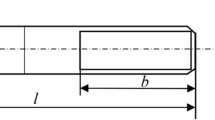Abstract
Quantitative characterization of contact pressure distribution in bolted joints directly influences the calculation accuracy of connection stiffness. In this paper, a three-dimensional finite element model of the bolted joints is established using the software ANSYS, and pretension force and contact between the joint components are accommodated in the model. Then, parametric studies are carried out to investigate the effects of the material properties, preloads, bolt sizes, grip lengths and hole clearances on the contact pressure distribution. According to the finite element analysis results, a polynomial equation system is derived for mathematical representation of contact pressure distribution in bolted joints. Furthermore, the conical envelope angle used in the mathematical characterization is identified for the bolted joints with different bolt sizes and grip lengths. Finally, an experimental platform is constructed for the measurement of contact pressure distribution, and then the applicability of mathematical characterization is validated by comparison with a series of experiment results.
Similar content being viewed by others
Abbreviations
- E :
-
Elastic modulus
- d :
-
Stud diameter
- d h :
-
Hole diameter
- d w :
-
Contact diameter of bolt head and upper plate
- D 0 :
-
Outer diameter of plates
- t 1 :
-
Thickness of upper plate
- t 2 :
-
Thickness of lower plate
- r :
-
Radius of pressure distribution
- L :
-
Grip length
- a :
-
Conical envelope angle
- σ :
-
Pressure distribution characterization
- P :
-
Pretension force
- ΔT :
-
Virtual temperature difference
- β :
-
Thermal expansion coefficient
- A :
-
Cross section area of bolt
- ℓ :
-
Scale factor
- T :
-
Tightening torque
- K :
-
Torque coefficient
References
N. L. Pedersen and P. Pedersen, On prestress stiffness analysis of bolt-plate contact assemblies, Archive of Applied Mechanics, 78(2) (2008) 75–88.
J. Armand, L. Salles, C. W. Schwingshackl, D. Süß and K. Willner, On the effects of roughness on the nonlinear dynamics of a bolted joint: A multicale analysis, European Journal of Mechanics/A Solids, 70 (2018) 44–57.
Y. Kwak, S. M. Park and J. Park, Dynamic properties of bolted joints in laminated composites evaluated using flexural wave propagation, Mechanics Research Communications, 92 (2018) 37–42.
F. Taheri-Behrooz, A. R. Shamaei-Kashani and R. N. Hefzabad, Effects of material nonlinearity on load distribution in multi-bolt composite joints, Composite Structures, 125 (2015) 195–201.
S. Bograd, P. Reuss, A. Schmidt, L. Gaul and M. Mayer, Modeling the dynamics of mechanical joints, Mechanical Systems and Signal Processing, 25(8) (2011) 2801–2826.
J. C. Musto and N. R. Konkle, Computation of member stiffness in the design of bolted joints, Journal of Mechanical Design, 128(6) (2006) 1357–1360.
M. B. Marshall, R. Lewis and R. S. Dwyer-Joyce, Characterisation of contact pressure distribution in bolted joints, Strain, 42(1) (2006) 31–43.
S. A. Nassar and A. Abboud, An improved stiffness model for bolted joints, Journal of Mechanical Design, 131(12) (2009) 1–11.
N. Haidar, S. Obeed and M. Jawad, Mathematical representation of bolted-joint stiffness: A new suggested model, J. of Mechanical Science and Technology, 25(11) (2011) 2827–2834.
M. Mantelli, F. H. Milanez and E. N. Pereira, Statistical model for pressure distribution of bolted joints, Journal of Thermophysics and Heat Transfer, 24(2) (2008) 432–437.
J. T. Stephen, M. B. Marshall and R. Lewis, An investigation into contact pressure distribution in bolted joints, Proceedings of the Institution of Mechanical Engineers Part C Journal of Mechanical Engineering Science, 228(18) (2014) 3405–3418.
R. H. Oskouei, M. Keikhosravy and C. Soutis, Estimating clamping pressure distribution and stiffness in aircraft bolted joints by finite element analysis, Proceedings of the Institution of Mechanical Engineers Part G Journal of Aerospace Engineering, 223(G7) (2009) 863–871.
M. Pau, A. Baldi and B. Leban, Visualization of contact areas in bolted joints using ultrasonic waves, Experimental Techniques, 32(4) (2008) 49–53.
R. Sethuraman and T. S. Kumar, Finite element based member stiffness evaluation of axisymmetric bolted joints, Journal of Mechanical Design, 131(1) (2009) 1–11.
J. Kim, J. C. Yoon and B. S. Kang, Finite element analysis and modeling of structure with bolted joints, Applied Mathematical Modelling, 31(5) (2007) 895–911.
F. Liu, X. Lu, L. Zhao, J. Zhang, N. Hu and J. Xu, An interpretation of the load distribution in highly torqued single-lap composite bolted joints with bolt-hole clearances, Composite Part B, 138 (2018) 194–205.
Acknowledgments
This work was supported by Science Challenge Project (No. TZ2018007) and National Natural Science Foundation of China (No. 51775410).
Author information
Authors and Affiliations
Corresponding author
Additional information
Recommended by Associate Editor Yang Zheng
Jianbin Cao received his M.S. degree in School of Mechatronic Engineering from China University of Mining and Technology in 2012. He is currently pursuing the Ph.D. degree in School of Mechanical Engineering, Xi’an Jiaotong University, Xi’an, China. His current research interests include dynamics and fault diagnosis of mechanical structures.
Zhousuo Zhang received the M.S. degree from Xi’an Jiaotong University in 1991, and the Ph.D. degree from Xi’an Jiaotong University in 2004. He is a Professor in the School of Mechanical Engineering, Xi’an Jiaotong University, Xi’an, China. He was a visiting scholar at the University of Southampton, Southampton, U.K., from 2006 to 2007. His current research interests include machinery condition monitoring and fault diagnosis, reduction and control of mechanical vibration and noise, and equipment fault prognosis and prediction of service life.
Rights and permissions
About this article
Cite this article
Cao, J., Zhang, Z. Finite element analysis and mathematical characterization of contact pressure distribution in bolted joints. J Mech Sci Technol 33, 4715–4725 (2019). https://doi.org/10.1007/s12206-019-0913-x
Received:
Revised:
Accepted:
Published:
Issue Date:
DOI: https://doi.org/10.1007/s12206-019-0913-x




